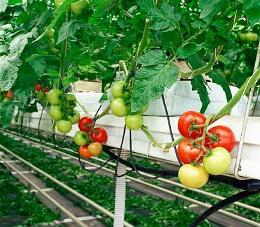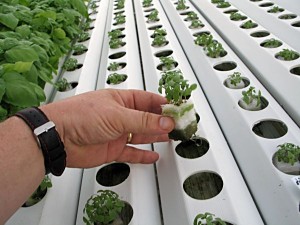 In Latin, the word hydroponics means literally “water working.”
In Latin, the word hydroponics means literally “water working.”
Hydroponics is the method of growing plants in nutrient-enriched water instead of soil—producing a healthier plant and healthier aromas. Plants grown using this method produce fruits and flowers with clearer, purer, more transparent scents. Impurities from soil and bacteria are eliminated, allowing hydroponically grown flowers to be used in the creation of fragrances for all scent applications.
In soil, biological decomposition breaks down organic matter into the basic nutrient salts that plants feed on. Water dissolves these salts and allows uptake by the roots. For a plant to receive a well balanced diet, everything in the soil must be in perfect balance. Rarely, if ever, can you find such ideal conditions in soil due to the lack of organic matter left behind on the surface, contamination and biological imbalances.
With hydroponics, water is enriched with these very same nutrient salts, creating a hydroponic nutrient solution that is perfectly balanced. And since this hydroponic nutrient solution is contained, it does not harm our environment as does runoff from fertilized soil. Additionally, very little water is lost to evaporation in a hydroponic system, owing to its application in drought stricken areas.
To support the plants in a hydroponic system, an inert soil-free medium like fiber, sand or stone, may be used to anchor the roots. These hydroponic mediums are designed to be very porous for excellent retention of air and water that’s necessary for a healthy plant – roots need to breathe too!
In addition to a perfectly balanced diet, hydroponic plants have their food and water delivered directly to their roots. This way, the energy normally used to develop long roots can be redirected to growing more plant, which is a great benefit indeed! With the proper exposure to natural sunlight or supplemental grow lights, your hydroponic plants .
Advantages of Simplified Hydroponics (SH) There are many advantages connected with this type of hydroponics. These include:
- It is a low-cost and easy-to-learn technique. A self-taught, inexpensive training course on popular hydroponics gardens provides the basic technological pack for SH. This has been promoted by the FAO/RLC as part of the strategy for urban agriculture to produce vegetable crops in limited urban and peri-urban spaces. It requires no previous knowledge, and concrete results may be seen by local communities within a few weeks.
- Allows the production of vegetables without soil in containers with water, or in low-cost natural substrates (sand, rice hulls, pumice stone, etc.). It allows the growth of a wide variety of vegetables such as lettuce, tomatoes, carrots, garlic, watercress, aubergine, beans, parsley, radish, leek, strawberries, melons, flowers, aromatic and medicinal plants, etc.
- Promotes the use of recycled materials, thus making low-cost materials such as wood and disposable containers, useful.
- It is ideal for food production in urban and suburban areas (Urban Agriculture).It offers the advantage of using places that have not previously been considered appropriate for food production (courtyards, small gardens, walls, balconies, rooftops).
- High efficiency in the use of water, but there is a requirement for uncontaminated water availability.
- Direct income for family or community micro-enterprises.
- Allows the production of high quality, harmless food. The resultant fruits and vegetables have a high biological and nutritional value. Since they are grown by each family, they are harvested immediately before their use, thus, products are fresh, keeping their nutritional and medicinal qualities intact. Also, it allows soilless cultivation that is free from contamination. In order to ensure the purity of the final product, it is essential that only drinking water and/or clean rainwater is used.
 Hydroponics is the science of growing plants using a solution of suitable nutrients instead of soil. In conventional gardening the plants are grown in soil and take their nourishment from the chemical compounds within that soil. The hydroponic gardener replaces the soil with a balanced, nutrient rich, solution that the plant can absorb with ease.
Hydroponics is the science of growing plants using a solution of suitable nutrients instead of soil. In conventional gardening the plants are grown in soil and take their nourishment from the chemical compounds within that soil. The hydroponic gardener replaces the soil with a balanced, nutrient rich, solution that the plant can absorb with ease.
There are several different types of system, but all share the same basic method of supplying the plants with nutrients and water. The most common systems are:
- Water Culture, Aquaculture, or Nutriculture. This is a system in which the plant roots are immersed in water containing a complex mixture of dissolved nutrients.
- Aggregate Culture. In this system a material such as sand, gravel, or marbles supports the plant roots. It is important to note that the support material, unlike soil, does not absorb nutrient. It merely traps it in the spaces between the grains or stones allowing the plant roots to freely take up the liquid.
- Continuous Flow Systems. In these types of system the nutrient solution flows constantly over the plant roots. This is the most commonly used system for commercial production.
- Aeroponics. This system is one in which the plant roots hang in the air and are misted regularly with a nutrient solution.
FAQ: All about Soilless Planting
What is soilless planting ?
Soilless planting is a method of growing plants using clean water or clean water or clean organic mater with or without additional plant nutrients:
- when clean water and nutrients are used, it is called “hydroponics”
- when clean organic matter like peat, compost, organic extracts are used, it is called “organics”.
Are these plant nutrients harmful to our body ?
All plants need 16 elements to grow. They are C, H, O, N, P, K, Ca, Mg, S, Zn, Cu, Fe, Mn, B. Mo and C1. In nature, the plants derive these elements from the atmosphere or minerals in the soil. Most of the elements used in preparing nutrient solutions are derived from these naturally occurring minerals. As such, they are not only natural but also very safe. They are sometimes purified to remove the impurities.
Some of the hydroponically grown vegetables look pale and do not seem to taste well. How do they compare with the soil grown vegetables?
The color of the hydroponically grown vegetables is mainly due to the availability of sunlight during the growing period. If more light is made available, then the vegetables will look dark green and if less light is available, they will look light green in color.
The taste of a vegetable depends on the genetic make-up of the plant. Different varieties will have a different taste. here is practically no difference in taste between the same variety of a hydroponically grown vegetable and a soil grown vegetable. The feeling is more psychological than factual.
Is hydroponics technology a commercially viable technology?
Hydroponics technology is a “green technology” that makes use of the natural plant growth phenomena in obtaining better results from plants. It is a very viable commercial technology. The success depends on the efficiency of the management team. There are many successful commercial operations around the world. Most airlines and fast-food chains used hydroponically grown vegetables. The cut flower industry, nurseries and the pharmaceutical industry are other sectors where this technology is practiced successfully.
Why is hydroponics getting more popular ?
When land, labor and natural resources get scare and when people look for healthy alternatives to farming and gardening, there is no better choice but to go for hydroponics.
- It is a very clean and hygienic way of growing plants both in small and large scales
- It is an ideal technology for “home farming”; it helps you to grow your own vegetables, fruits, flowers, herbs etc.… the way you like.
- It is very educational, as young children can see and learn more about the wonders of the plants.
- As you get immersed in this method of planting, it helps you to forget all your worries…so it is good for heart patients, sick and disabled people and people with a lot of stress in their work place.
- It is also a “healthy lifestyle” for healthy people.
Hydroponics has been practiced commercially since 1940s. However, it is only quite recently that it become popular as a healthy life style for individuals and families.
How about the mosquito problem?
If the instructions in preparing the nutrient solution and maintaining their concentration in the hydroponics systems are carefully followed, mosquitos will never breed. This is because the ionic concentration in the solution is too strong for the wrigglers to survive.
Sources: www.howtohydroponics.com, www.edu.gov.nf.ca; Photos: thegardencentral.com, dynamic.org.